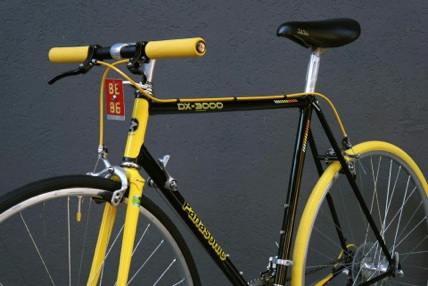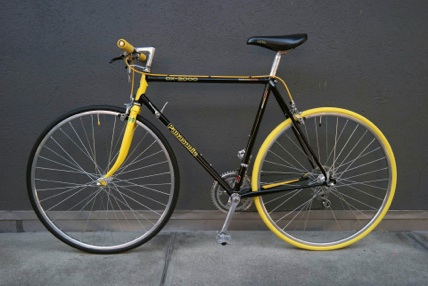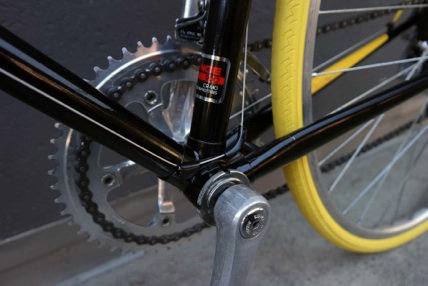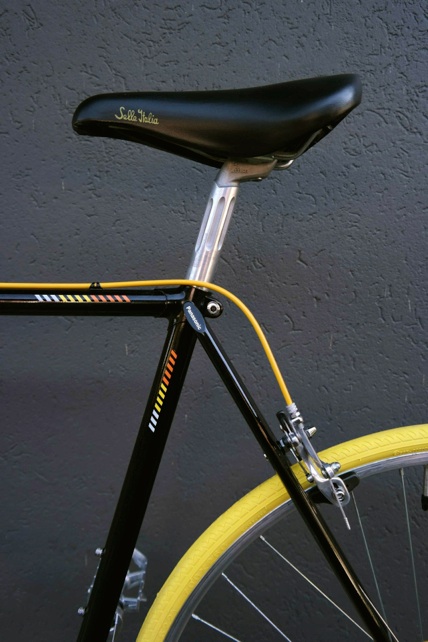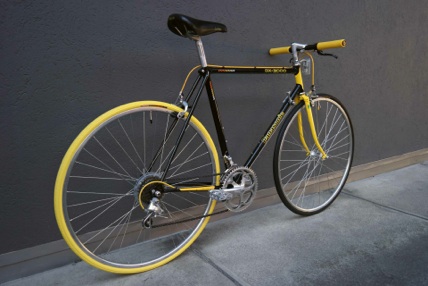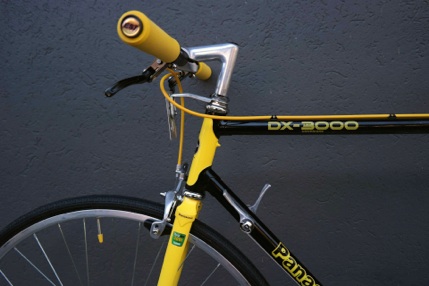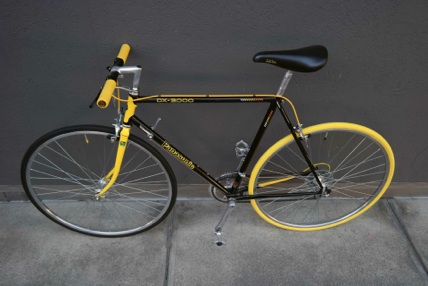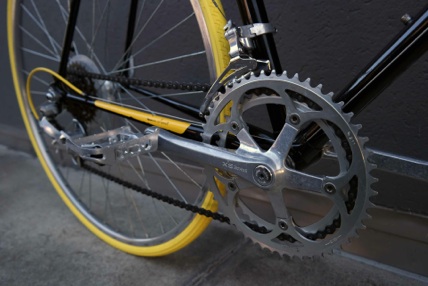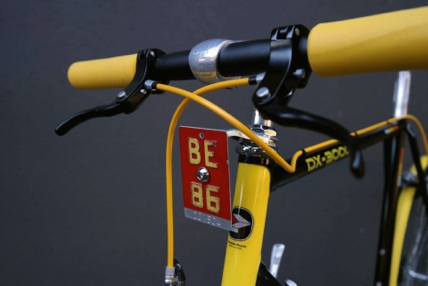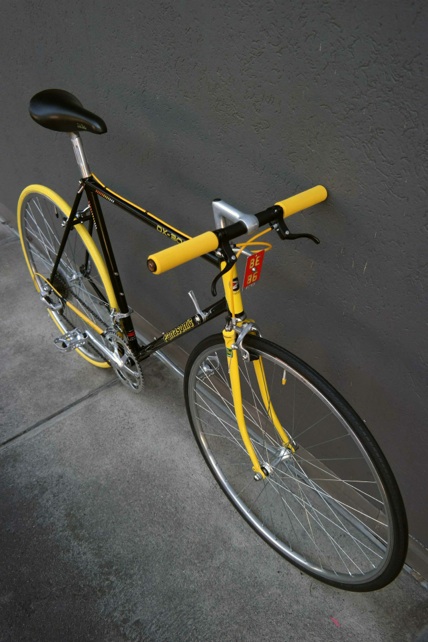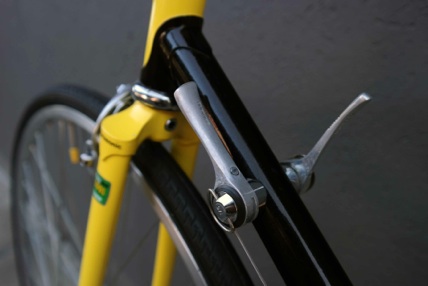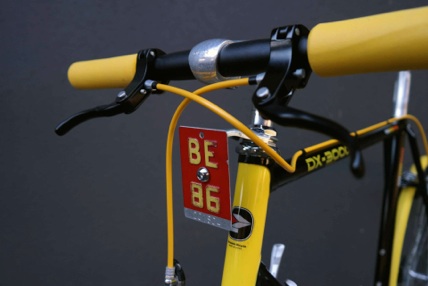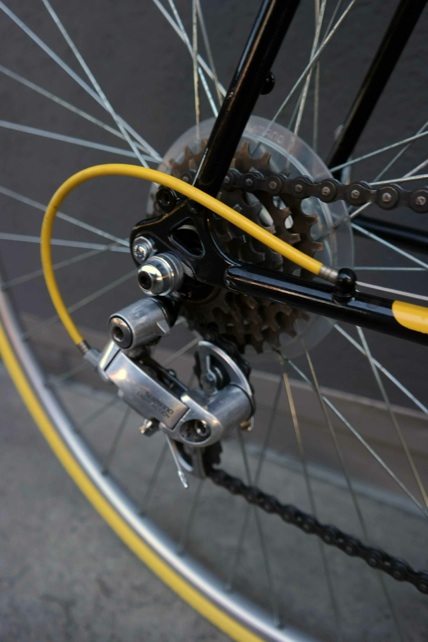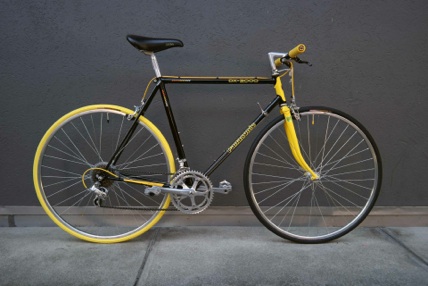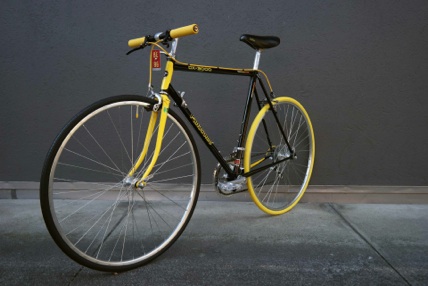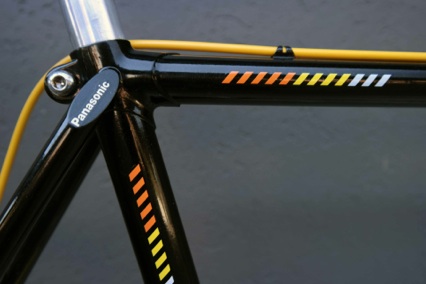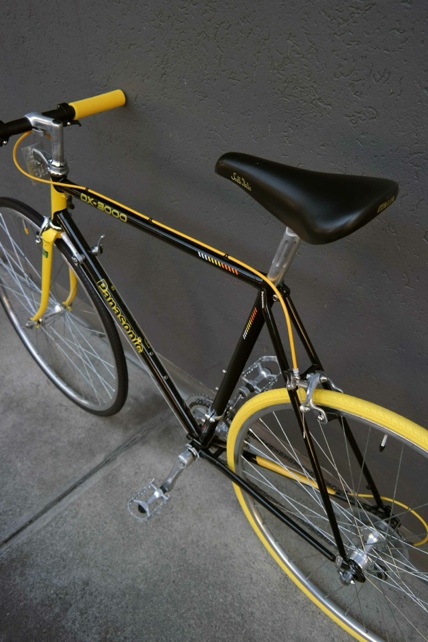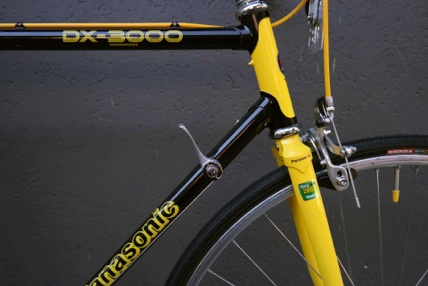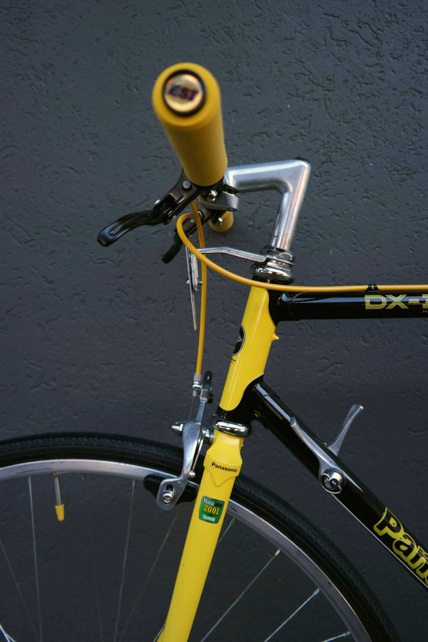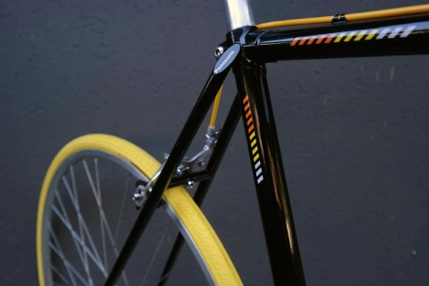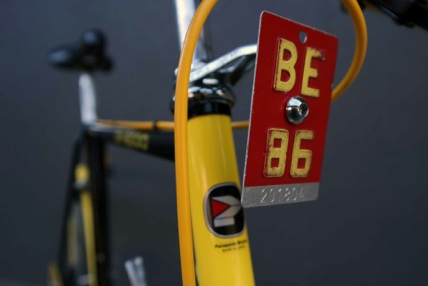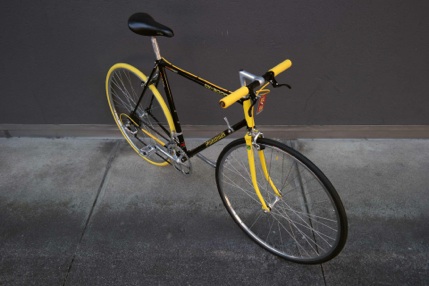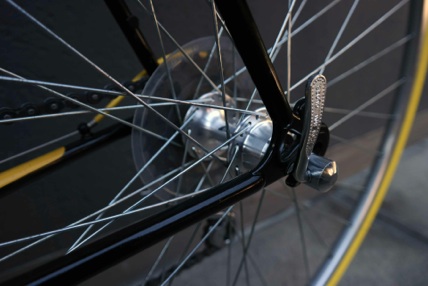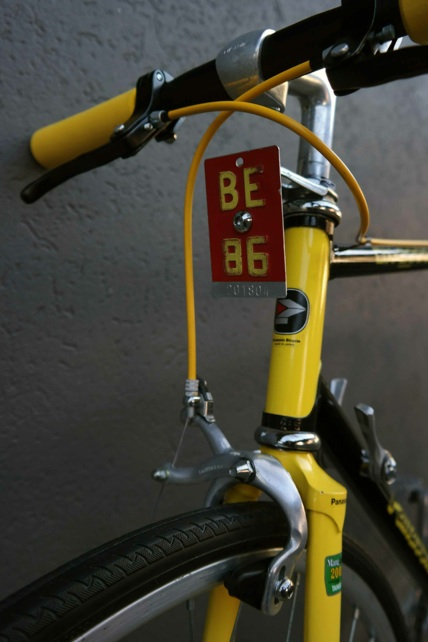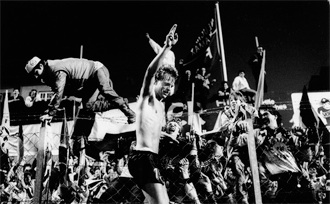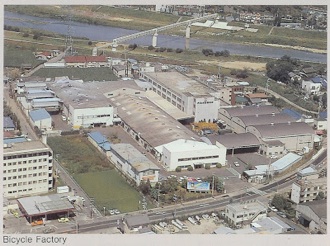Marke:
Typ:
Nickname:
Code:
Farbe:
Jahrgang:
Masse:
Rahmen:
Gabel:
Rahmen-Nr.:
Bremsen:
Bremshebel:
Schalthebel:
Schaltwerk:
Umwerfer:
Lenker:
Lenkergriffe:
Kurbel:
Pedale:
Reifen:
Felgen:
Nabe:
Sattel:
Beschrieb:
Racer: Panasonic DX-3000, gelb-schwarz

Panasonic
Panasonic DX-3000 Renner, gerader Lenker, 12-Gang
„Lars“
trds105: t.rides.panasonic.86.03.2016
gelb-schwarz
1986
560 mm (Sattelrohr, Mitte Tretlager bis OK Sattelrohr)
560 mm (Oberrohr, Mitte Sattelrohr bis Mitte Steuerrohr)
Für Körpergrössen von 168 - 180 cm geeignet
Tange 900 Cr-Mo double butted, Stahlrahmen gemufft
Tange Mangaloy 2001, AC-2 crown
6E15485
Shimano, BR-257
Promax Retro B-Lever, 22.2 mm, schwarz (neu)
Shimano, S424
Shimano, Light Action
Shimano, FD-Z206
Gerader Lenker BT-Swiss Alu matt, 46cm breit (neu)
ESI Grips Chunky, gelb (neu)
Sakae SX
KKT Pro-Vic II BC
HR: Kenda Kontender Comp (700 x 26C), gelb (neu)
VR: Kenda Kontender Comp (700 x 26C), schwerz (neu)
Ukai 20A, 700c, ALU
Sansin, JPN
Selle Italia 0419-V Aero
Wohl kaum zu Ehren des Berner Fussballclubs „Young
Boys“ hat Panasonic das 1986er Rennrad Modell
DX-3000 in den Farben gelb / schwarz designed.
Tatsache jedoch ist, dass YB im selben Jahr zum bisher
letzten Mal den Schweizer Meistertitel gewann.
Der Däne Lars Lunde, Publikumsliebling und Star der
Mannschaft sorgte in dieser Meistersaison für Furore,
wurde Torschützenkönig und schoss zusammen mit
Dario Zuffi am 24. Mai 1986 den BSC YB in der
Neuenburger Maladière zum Titel.
Seit nunmehr 30 Jahren warten wir Fans auf einen
nächsten Meistertitel. Als gutes Omen wurde dieser
bisher beinahe unbenutzte Panasonic Renner nach
dreissig Jahren aus dem Dornröschenschlaf erweckt und
liebevoll in passender Farbcombo aufgefrischt. Vielleicht
klappt es ja auch bald wieder mal mit einem Titel für
Gelb-Schwarz.
VERKAUFT,
nach Bern-Liebefeld.
Kundenrückmeldung:
„Zwar nicht ganz so schnell wie Marco Pantani zu seinen besten Zeiten, aber immerhin EPO-frei den Berg hinauf gekraxelt!
Lars & ich geben ein tolles Duo ab - von der Freundin offiziell bestätigt ;-)
Vielen Dank für die tolle Büez - es fägt hunnä!“
Glg, Nik
Herleitung des Übernamens: „Lars“
Lars Lunde (* 21. März 1964 in Nyborg) ist ein dänischer Fußballtrainer und ehemaliger Fußballspieler.

Lunde ging aus der Jugend von B 1909 Odense hervor und rückte in die erste Mannschaft auf, die 1982 in die 1. Division, der höchsten dänischen Spielklasse, aufgestiegen war. In seiner Premierensaison im Seniorenbereich absolvierte er 28 von 30 Ligaspielen und erzielte fünf Tore. Da der Verein als Tabellenletzter in die 2. Division abgestiegen war, wechselte er zu Brøndby IF, einem Verein im Vorort von Kopenhagen. Für diesen bestritt er in zwei Spielzeiten 56 Ligaspiele, war zehnmal als Torschütze erfolgreich und belegte mit der Mannschaft zweimal den vierten Tabellenplatz in der Meisterschaft.
Im Alter von 20 Jahren wechselte er in die Schweizer Nationalliga zum BSC Young Boys, für den er von Ende 1984 bis Mitte Saison 1986/87 55 Ligaspiele bestritt und 30 Tore erzielte. 21 davon erzielte er in 27 Saisonspielen 1985/86, mit denen er Torschützenkönig wurde und damit zur ersten Meisterschaft seit 26 Jahren beitrug.
Während der laufenden dritten Saison wurde er im Oktober 1986 vom FC Bayern München verpflichtet. Seinen Einstand gab er am 18. Oktober 1986 (11. Spieltag) beim 1:1 im Auswärtsspiel gegen Blau-Weiß 90 Berlin. Am 28. März 1987 (22. Spieltag) erzielte er beim 2:1-Sieg im Auswärtsspiel gegen den Hamburger SV sein erstes Tor. In den 21 Spielen seiner ersten Saison erzielte er zwei und in den neun der darauf folgenden ein Tor. Des Weiteren kam in acht Spielen um den Europapokal der Landesmeister zum Einsatz – einschließlich des mit 1:2 verlorenen Finales gegen den FC Porto – und in drei um den DFB-Pokal.
1988/89 spielte Lunde auf Leihbasis wieder in der Nationalliga A beim FC Aarau unter Trainer Ottmar Hitzfeld, in der Folgesaison beim Zweitligisten FC Zug und 1990/91 beim FC Baden.
Die nach einem Verkehrsunfall am 12. April 1988[1] davongetragenen Verletzungen, von denen sich Lunde nicht mehr erholte, waren der Grund seines Karriereendes mit 26 Jahren.
Nationalmannschaft
Lunde debütierte am 25. Oktober 1983 in der U-21-Nationalmannschaft, die in Budapest mit 1:5 gegen die Auswahl Ungarns verlor; in diesem Spiel erzielte er auch sein erstes Tor. Sein letztes Spiel für diese Auswahlmannschaft bestritt er am 26. März 1986 in Manchester im Viertelfinal-Rückspiel der U-21-Europameisterschaft beim 1:1-Unentschieden gegen die Auswahl Englands.
Für die A-Nationalmannschaft bestritt er drei Länderspiele; erstmals am 5. Oktober 1983 in Århus bei der 0:1-Niederlage gegen die Auswahl Polens, letztmals am 29. April 1987 in Helsinki beim 1:0-Erfolg über die Auswahl Finnlands.
Nach seinem Karriereende wurde Lunde in der Schweiz sesshaft und arbeitete als Lagerungspfleger in einer Operationsabteilung im Kantonsspital in Aarau und trainierte ab August 2006 die B-Jugend des FC Wangen bei Olten. In der Saison 2010/11 war er Cheftrainer des FC Bern in der 2. Liga interregional, der fünfthöchsten Spielklasse in der Schweiz. 2012 übernahm er das Traineramt beim SC Worb in der 2. Liga, der sechsthöchsten Spielklasse in der Schweiz.
Er ist geschieden und ist Vater eines Sohnes und lebt in Bern.
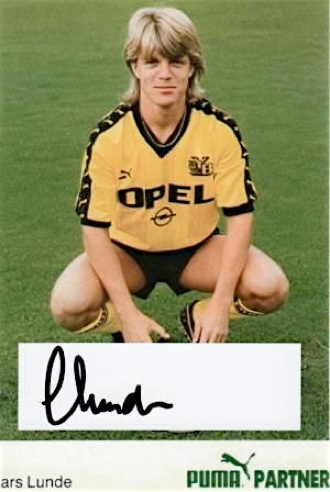
Spielbericht Xamax-Young Boys:
https://www.youtube.com/watch?v=FoJarrgf6eQ
Zusatzinformationen zu diesem Objekt:
The History of Panasonic Bicycles
Mr. Konosuke Matsushita was the man behind the National/Panasonic company. As a child he was adopted into a family who owned a bicycle shop. He passion for bicycles began at an early age and before long he was creating new innovations for the benefit of the cycling world.
In Japan, Mr. Matsushita’s company was known as National. This presented problems when looking to sell products in other countries such as the USA, so the name Panasonic came about for use on exported products.
Mr. Matsushita was always passionate about his bicycles and he refused to put his name on something he considered to be less than a quality product. Perhaps this would explain why even the inexpensive low-end models such as the Sport 500 seemed to be so much nicer than the boat anchor department store bikes being sold at the time.
Matsushita was also known for his Panaracer brand bicycle tires. He created the first successful synthetic tubular tires and Panasonic tubular cement is also highly regarded.
Panasonic Historical Timeline
-
•1918 – Mashushita Electric founded. (Parent company that would eventually be known as Panasonic)
-
•1923 – A new battery powered bicycle headlamp was developed and distributed to bicycle dealers.
-
•1951 – Bicycle frame production begins
-
•1952 – Production of a roadster-model bicycle by C.K.D.
-
•National Tire Company established
-
•1956 – Sport type bicycle production begins
-
•1958 – Received license of sticking certification mark of J.I.S. (Japan Industrial Standard) for frames from M.I.T.I. (Ministry of International Trade and Industry)
-
•1962 – Received license of sticking certification mark of J.I.S. for complete bicycles from M.I.T.I.
-
•1965 – Factory established in Kashihara city in Osaka, Japan and National Bicycle Ind. Co. was established
-
•1967 – Japanese national bicycle racing team adopts use of our bicycles for World champion competition.
-
•1971 – Began to export Panasonic bicycles to Panasonic Company U.S.A. Also began to export bicycles to Schwinn Bicycle Company U.S.A.
-
•1972 – Japanese Olympic Bicycle Team adopted our racing bicycles for Munich Olympics.
-
•1973 – Reward received for quality control from Osaka division of M.I.T.I.
-
•1974 – Gojyo National Bicycle Parts Co. Ltd. established (wheel assembly factory)
-
•1976 – Japenese Olympic Bicycle Team adopted our bicycles for the Montreal Olympics. Only our Racing and 10 Speed bicycles were selected as up-to-date bicycles among the world bicycling manufacturers and demostrated at Benjamin Franklin Institute in Philadelphia for the American Bicentenial Celebration.
-
•1979 – Began to export frames and bicycles to Europe.
-
•Began to export frames and bicycles to Canada.
-
•Began to export frames and bicycles to Austrailia.
-
•Organized Panasonic/Shimano Racing Team in U.S.A.
-
•1980 – Began to export bicycles to T.I. Raleigh (U.S.A.)
-
•Japanese Olympic Bicycle Team adopted our racing bicycles for the 1980 Moscow Olympics
-
•1989 – Panasonic Bicycles pulls out of North American market after the Dollar/Yen ratio makes bicycle market too unprofitable.
-
•TODAY – Panasonic continues to build high quality bicycles for other world markets. A small number of bikes and frames remain available to North America through Madison, Wisconsin based Yellow Jersey Bicycles.
Panasonic in North America
Panasonic began exporting bikes to the U.S. way back in 1971. Those were the early bicycle boom days and Panasonic having been a bicycle maker for many years wanted in on the market.
We were lucky enough to be put in touch with the ex National Sales Manager for Panasonic’s bicycle division here in the U.S., Mr. Norman Halperin. Panasonic was Norman’s initial entry into the bicycle industry – starting with Panasonic on April 19th, 1979 as a Sales Rep covering Metro New York, New Jersey and Connecticut. At the time Panasonic had only one other Rep in the Chicago area and after another six months he left the company.
With only six months experience in the bike business Norman found himself being a senior man in sales department. It was at that point that Panasonic decided to go nationwide and Norman became the National Sales Manager and started hiring reps all over the country.
Panasonic bikes hiding behind other labels…
You may be surprised to learn that Schwinn, Raleigh, Royce Union, Suteki, Centurion and other labels all at one time or another had Panasonic built bicycles wearing their badges. Schwinn’s very first outsourced bikes back in the early 70s were built by Panasonic. These were the “World” bikes such as the World Traveller and World Voyager. Later on in the 70s, Schwinn made a deal with Panasonic to build the LeTour model which would become the second most popular model for Schwinn in the 1970s
(Fotos und Infos:
www.panasonicbikemuseum.info/1986-panasonic-dx-3000/ )
